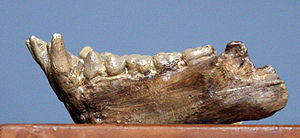- Pliopithecus
-
Pliopithecus 
Pliopithecus antiquus aus Sansan, Frankreich
Zeitraum Miozän bis Pliozän 16 bis 11,1 Mio. Jahre Fundorte - Europa und Asien
Systematik Teilordnung: Altweltaffen (Catarrhini) Überfamilie: Pliopithecoidea Familie: Pliopithecidae Tribus: Pliopithecini Gattung: Pliopithecus Wissenschaftlicher Name Pliopithecus Gervais, 1849 Arten - Pliopithecus antiquus Gervais, 1849
- Pliopithecus platyodon Biedermann, 1863
- Pliopithecus zhanxiangi Harrison et al., 1991
- Pliopithecus piveteaui Hürzeler, 1954
- Pliopithecus sp. [Spain] [Begun, 2002]
- Pliopithecus canmatensis Alba et al., 2010 [1]
Pliopithecus ist eine Primatengattung mit mehreren beschriebenen Arten des Miozän und Pliozän und lebte vor etwa 16 bis 11 Millionen Jahren vor heute. Er scheint in Europa und Asien weit verbreitet gewesen zu sein, findet sich jedoch kaum einmal in Afrika. Seine Nahrung war rein vegetarisch, er ernährte sich von Blättern und Früchten. Der Pliopithecus wurde nur etwa 20 bis 40 cm groß, sein Aussehen dürfte an einen modernen Gibbon erinnert haben, obwohl seine Arme nicht so extrem lang waren wie bei den modernen Vertretern. Er wurde 1837 von Edouard Lartet (1801–71) in Frankreich entdeckt. Der Pliopithecus gilt als möglicher Vorfahre der modernen Gibbons.
Morphologische Ähnlichkeiten mit Pliopithecus antiquus weist Lomorupithecus harrisoni auf.
Literatur
- K. C. Beard: Basal anthropoids in W. C. Hartwig (Hrsg.): The Primate Fossil Record. Cambridge University Press, Cambridge, England, 2002, xiv-530. Seiten 133-149.
- D. R. Begun: The Pliopithecoidea in W. C. Hartwig (Hrsg.): The Primate Fossil Record. Cambridge University Press, Cambridge, England, 2002, xiv-530. Seiten 221-240.
- R. L. Carroll: Vertebrate paleontology and evolution. W. H. Freeman and company, New York, 1988, 698
- R. L. Carroll: Appendix. in: R. L. Carroll: Vertebrate paleontology and evolution.594-648 in Carroll, R. L., 1988: Vertebrate paleontology and evolution. W. H. Freeman and company, New York, 1988, 698
- J.G.Fleagle: Primate adaption and evolution. Academic Press, New York, 1988
- L. Ginsburg: Les faunes de mammifères terrestres du Miocène moyen des Faluns du bassin de Savigné-sur-lathan (France). Geodiversitas: Vol. 23, #3, pp. 381-394
- M.C. McKenna & S.K. Bell (Hrsg.): Classification of mammals – above the species level. Columbia University Press, New York, 1997, xii-631
- D.T. Rasmussen: Early catarrhines of the African Eocene and Oligocene. 203-220. in: W.C. Hartwig (Hrsg.): The Primate Fossil Record. Cambridge University Press, Cambridge, England, 2002, xiv-530
- E.L. Simons, P. Andrews & D.R. Pilbeam: Cenozoic apes. 120-146. in: V.J. Maglio & H.B.S. Cooke, (Hrsg.) : Evolution of African Mammals. Harvard University Press, Cambridge, Massachusetts, London, England, 1978, xiv-641
Einzelnachweise
- ↑ [1], American Journal of Physical Anthropology, Band 141, Nr 1, S. 52–75
Discovery of a primate more than 11 million years old
Weblinks
- The Hylobatidae from the late Miocene of Lufeng, Yunan, Acta Anthropologica Sinica, August 1984, Vol. 3, Number 3, pp 185-194 (PDF-Datei; 52 kB)
- Beschreibung des Pliopithecus vindobonensis
- Mikko's Phylogeny Archive, möglicher Stammbaum mit den einzelnen Arten
- Bilder von Funden
- Rekonstruktionsversuch
Kategorien:- Menschenartige
- Ausgestorbener Primat
- Hominoidea
- Fauna des Miozäns
- Fauna des Pliozäns
Wikimedia Foundation.
